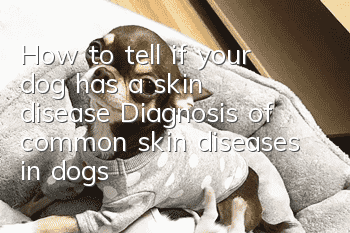How to tell if your dog has a skin disease? Diagnosis of common skin diseases in dogs

Mites live under the pet's skin. They are not attached to the skin and hair. They are so small that they are invisible to the naked eye. Some parents think that they can be removed mechanically like fleas, but this is impossible. Only drugs can remove and kill them. The image below was observed under a microscope and drawn manually.
Mites
Dear, let’s take a look at whether your baby has the following symptoms. If they are similar, it is likely that he is infected with mites:
(1) Scabies: This disease is highly contagious and the causative agent is the canine scabies mite. The examination revealed that the worms were mainly parasitic on the outside of the ear tip. Tail root and paws. Lesions often occur in areas with thin skin and sparse hair, such as around the mouth and eye circles. In severe cases, they can spread to the whole body. Showing severe itching. Constantly scratching and biting, resulting in hair loss and knotting in the affected area, as well as on the edge of the ear shell. The skin at the base of the tail and paws is thickened and densely covered with bran-like thick scabs. Mites and insect eggs can be found in the scabs on the affected areas. The disease is mainly transmitted through contact. Poor sanitary conditions such as overcrowding, darkness, and humidity will aggravate the occurrence and development of the disease. People can also be infected by contact with sick dogs.
Infection on the forehead: redness, hair loss, and scabbing
Ventral armpit infection: hair loss, erythema, papules
(2) Demodicosis is caused by the canine Demodex mite parasitizing hair follicles and sebaceous glands. An autopsy found that in severe cases, the worms can parasitize in the dog's lymph nodes and other tissues. The worms can even be found in the dog's ear canal and between the toes (fingers). Systemic acariasis is often caused due to decreased immune function. The investigation found that there are two types of insects: large and small. The average size of large worms is 222.75 microns x 44.55 microns, and the average size of small worms is 168.17 microns x 39.6 microns. The large worms have strong pathogenicity. . At the beginning of the disease, the skin on both sides of the dog's face is flushed and congested, followed by hair loss and the formation of many wrinkles, and then spreads to the forehead, back, chest and abdomen, and even the whole body. Papules and pus cancer rashes the size of beans are scattered in the affected area, accompanied by hair loss and Seborrhea. A large number of parasites can be found by taking the skin or pus from the affected area. A simple Demodex infection generally does not cause obvious itching, but if it is accompanied by a fungal or scabies infection, the itching will be aggravated. Dogs are naturally infected with Demodex at a high rate. But the incidence rate is about 10.00%. The investigation found that the disease can be transmitted through the placenta. 80%-100% of the offspring of an infected female dog will develop demodicosis. The puppies are usually born and have typical symptoms after 2 months. Demodex can also develop resistance to ivermectin preparations. Therefore, the disease has been increasing year by year in the past two years.
Demodex infection: large areas of ringworm, hair loss, papules
The picture below shows a long-term lack of treatment or ineffective treatment, resulting in severe mites combined with fungal infection, which is simply terrible!
Mixed infection of mites and fungi: redness, swelling, hair loss, skin peeling, ulceration, bleeding, and scabs
This picture is not to scare you. If the mites carried by dogs infect your family, the result will be like this.Yo! The symptoms of tinea manuum and tinea pedis are a little different. Have you encountered it? Of course, it’s a good thing if you haven’t encountered it, but you have to be careful!
Mites and fungi infect humans: tinea manuum and tinea pedis
(3) The cause of ear itching mite is ear itch mite, which mainly lives in the dog's ear canal and sometimes crawls to other parts of the body to cause local damage. The main clinical manifestations are inflammation and congestion of the ear canal, a large amount of reddish-brown or gray-white secretions in the ear canal, and a fishy odor. The inside of the ear shell is flushed and eroded. The dog keeps scratching its ears and cheeks, or rubs its head against the ground or cage wall, and thumbs are scattered on the body surface. Cover the large blood scab and form a hairless area. The ear canal secretions were taken and pressed into tablets, and a large number of ear itching mites and insect eggs were found under microscope examination. Examination found that clinical otitis media is mostly caused by ear itch mites. Otoitch mange is mainly spread through contact
(4) Fungal skin disease manifests as severe itching, severe hair loss over a large area, red papules scattered on the body surface, and the hair loss area is covered with oily thick scabs. The scabs are scraped off to expose the flushed or ulcerated epidermis. In severe cases, ulcers form. As the course of the disease prolongs, pigmentation appears in the affected area, and the hair roots are easy to fall off and the hair shafts are easy to break. Microscopic examination of the hair roots in the affected area shows that the hair roots shrink and look like sorghum ears, with a large amount of bamboo leaf-like microspores attached, and the hair shafts are tube-shaped. The hair shaft is surrounded by dense microspores. This disease is often mixed with scabies and demodectic mites, causing each other to aggravate the occurrence and development of the disease. Skin diseases caused by Trichophyton are less common. Clinically, circular hair loss areas the size of thumb caps can be seen on the trunk, limbs and other parts of the body, so it is also called "money tinea". The appearance is like sika deer markings, with residual hair roots and chaff-like drums in the hair loss areas. The dandruff, itching and skin lesions are not obvious. This disease is mainly caused by a moist, dark environment, overcrowding and low resistance. Severe scabies and demodicosis can induce fungal infections.
(5) Nutritional deficiency skin disease. This disease is mostly caused by improper feeding management and digestion and absorption disorders leading to a lack of certain vitamins and trace elements. For example, dogs are fed high-protein and high-fat foods for a long time, egg yolks or spoiled feed for a long time. It can cause deficiencies in vitamin C, vitamin B, selenium, and calcium. The coat of the affected dog is dry and dull, and the hair is easy to break and fall off. There are bleeding spots on the skin surface as big as a bean or the size of a thumb cap, increased dandruff, and no obvious itching.
- How to protect your dog’s food? Teach you tips on training your dog
- What should I do if my dog has lupus? Immune system diseases should not be underestimated
- Do dogs need deworming in summer? What should you pay attention to when raising dogs in summer?
- What should you pay attention to when vaccinating your dog? What should you pay attention to when vaccinating your dog?
- Symptoms of Rheumatism in Dogs What conditions can cause rheumatism in dogs?
- What to do if dogs fight at home? The owner is the best mediator
- What are the reasons why dogs are obese? Do you know these four reasons?
- The Disadvantages of Dogs Eating Leftovers Stop Feeding Your Dog Leftovers
- Symptoms of protein deficiency in dogs How to supplement protein
- How to treat pica in dogs? Have you seen your dog eating randomly?



